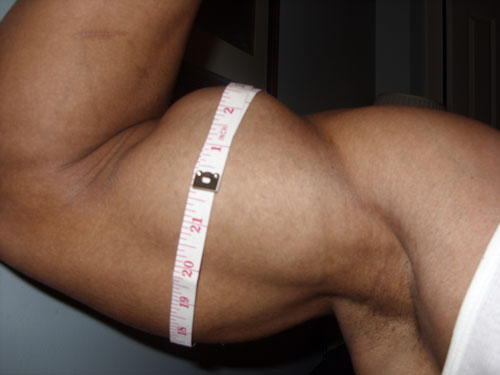Several media outlets recently published an astonishing finding: strong men are more conservative. Based on an article in Psychological Science, the popular accounts stray far from the research and probably even further from the truth. In this two-part post, we’ll discuss what the researchers actually said (Pt. I) and what their research might actually mean (Pt. II).
Strong Men are Conservative!

Last week, my Facebook feed brought me some intriguing news: researchers apparently discovered that physically stronger men tend to hold conservative economic views.
A couple quick clicks and a Google search showed ample coverage, much in conservative media, of the peer-reviewed article. Michael Bang Petersen and his coauthors did, indeed, find a relationship between physical strength and political attitudes.
The study’s authors examine the connection between strength and politics by interviewing men and women in three countries (Argentina, Denmark and the United States). They measure the flexed, dominant-arm bicep of participants, and ask them a battery of political questions. The relationship is “statistically significant” at conventional levels.
So, are beefy men more conservative? Nope. Popular accounts of the research misinterpret the findings, which are themselves oversold by the authors. At no point do the data provide exhaustive support for the theory that physical strength causes any part of one’s political views, much less that it makes men more conservative.
Leveling the mountain to uncover the molehill
The study’s authors nest their theory in the evolutionary advantage strong men enjoy in physical conflicts. Members of the conservative press seemed to love this story, and thus extracted the evolutionary thread without reading beyond the article’s abstract.
The logic, according to the popular accounts, claims that since nature favors strong males, these same males will eschew social safety nets. They don’t need it, after all, and would rather not see the fruits of their strength redistributed to the ninnies.
Here’s the kicker: that’s not at all what the authors claimed to find. For the story above to be supported by data, we would expect bicep size to positively correlate with conservative views. It’s presumably not, given that they don’t publish that finding.
The authors posit instead that strength interacts with other characteristics to affect political views. They point out that traditional rational decision making models don’t perform so well in the electorate, especially when using economic wellbeing to predict attitudes. That is, rich people tend to support redistribution less than poorer people, but the relationship between wealth and economic attitudes isn’t as clean as we may expect.
Here enters strength: stronger males may be more willing to engage in self-interested behavior than their weaker counterparts. The authors explain that strong males would, in nature, be more likely to claim resources because they are more able to defend them, and the same may be true of political resources. Strong, rich men may be more willing to fight against redistribution, while stronger, poor men may be more willing to claim resources through redistribution.
That’s a horse of a different color. According to the authors’ account, strength does not predict conservatism, but instead predicts the congruence of personal economic status and political views. The authors do not present a correlation between strength and attitudes, but an interaction term between bicep size and wealth that together predict conservatism.[1]
How did it go so wrong?
I have several quibbles with the original research, which we’ll explore in Part II, but we should be clear: the authors did not claim to have found that strength relates to conservatism. That’s wholly an invention of either lazy or ulteriorly motivated journalists.
On one level, this shouldn’t be surprising. Of my friends who posted stories about the research, all are quite conservative. The story provides a feel-good boost to people who identify with conservative politics, and it’s not odd that they would share the good news.
Second, the original theory matches our collective political notions. Cowboys are conservative, academics are liberals; soldiers are conservative, environmentalists are liberals. Given this natural frame, it’s easy enough to package the findings in a way that calls to mind these biases. Of course strong men oppose redistribution! They’re rugged, self-sufficient, independent, and thus the perfect candidates for conservative political views. The more nuanced story, of strength conditioning self-interest, is more difficult to tell and less intuitive, so it gets left by the roadside.
Third, media face powerful incentives to hyperbolize. “Strong men are more conservative” is flashier and more provocative than “strong men more likely to act self-interested in economic policy preferences.” A story guaranteed to tickle conservatives and enrage liberals will also attract more shares, tweets, and trackbacks in the blogosphere. If there’s no such thing as bad publicity, perhaps there’s also no such thing as bad web traffic.
Surprising or not, the coverage should still be depressing and alarming. In an era where we’re debating the role of social science research in society, it’s important to understand how the public accesses major findings and how these may improve the democratic process. News media play an important role here, but that responsibility is corrupted when journalists choose sexy over scientific.
In Part II, we’ll discuss the research by Petersen and his colleagues, and explore the relationship between strength, economics and political attitudes.
Notes:
1. Interaction terms are both used and misused frequently in statistical models. The intuition of interaction goes something like this: If I believe that some characteristic (say, being male) conditions the effect of another characteristic (opinions about equal pay laws) on an outcome (vote), I can interact the two independent variables (i.e., multiply them together) and include this new interaction term into the model. In this example, for instance, I may believe that women’s views of equal pay will strongly influence the candidate for whom they’ll vote, while it won’t really influence men. This gives us two “versions” of the relationship between “equal pay attitudes” and “vote,” one steep line for women and one less steep line for men.

Pingback/Trackback
Seeing Red: A Statistics Debate